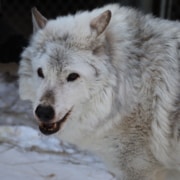Midwinter dominance
The dynamics within the Exhibit Pack continue to shift. With the absence of a dominant male and female pair, the pack is not as settled as it would be in the presence of a dominant pair. It is likely that we will not see a fully settled pack structure until we welcome the 2020 pups into the Exhibit. Once the new pups have matured, we expect to see a male/female pairing that will create solid leadership within the pack.
Staff are working with Axel, helping to assert a little bit of dominance over him, encouraging him to submit and providing a positive reinforcement when he does. Staff must be mindful to not have him submit when Grayson is nearby, as we do not want Grayson to take advantage of him while he is in a vulnerable position. Distractions such as deer hides and legs, play a key role in helping keep Axel’s attention on something other than Boltz. These techniques have proven successful in reducing Axel’s focus and overall intensity of interactions. He still has some issues with personal space, often standing or lying inches away from another wolf despite their lip curl and growl warning him that he’s in their bubble.
Over the weekend, Denali controlled the carcass during the weekly “What’s for Dinner?” program. What was interesting was that he allowed Boltz to feed on the carcass with him, but he didn’t let the arctic’s on the carcass. It is always a challenge to assess correlation and causation in science, but within a day after the feeding, Boltz seemed to gain a little bit of power. Boltz has been steadily gaining confidence ever since and participates in pack rallies, yet he still isn’t fully comfortable around Axel. Denali seems to be source of security for Boltz and each morning, Denali and Boltz emerge from the main den together.
Written by Assistant Curator, Leanne Martin
















